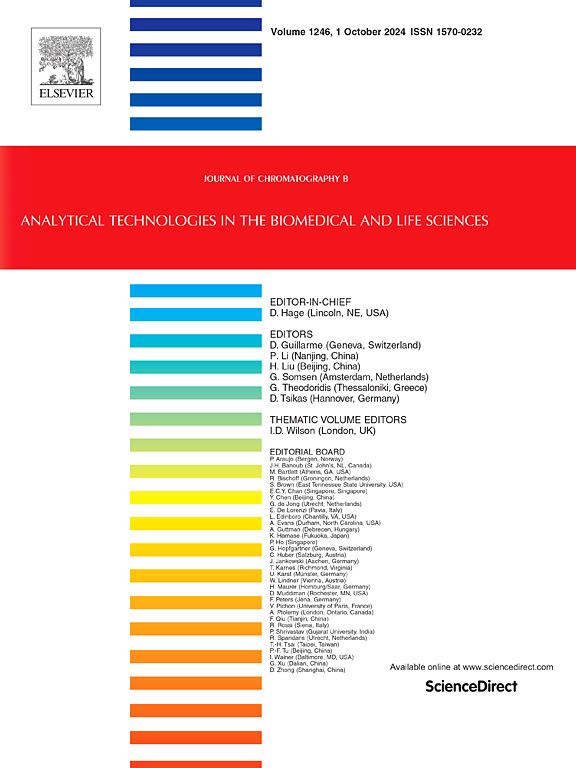UHPLC-based C-phycocyanin quantification method to support the validation of remote sensing models for harmful cyanobacterial blooms
IF 2.8
3区 医学
Q2 BIOCHEMICAL RESEARCH METHODS
引用次数: 0
Abstract
The deployment of hyperspectral satellite missions has opened new opportunities for integrated approaches to address the escalating issue of cyanobacterial algal blooms in marine and inland waters. Despite these advancements, the validation of satellite data concerning C-phycocyanin (C-PC) content requires robust analytical methods. Currently, the available techniques, predominantly spectrophotometric or fluorometric, exhibit low reproducibility due to the interference of chlorophyll a and perform optimally with water samples. The samples collected during ship-based campaigns and commonly used for satellite data validation are concentrated samples on filters, which limiting the application of these methods. In this study, we aim to establish an Ultra High Pressure Liquid Chromatography (UHPLC) -based method for C-PC quantification in water samples concentrated on filters to validate satellite derived algorithm for monitoring cyanobacteria blooms. This involves the extraction of C-PC from pure algal cultures (Synechococcus spp. and Anabaena spp.) and natural samples fixed on filters and the quantification employing UHPLC analysis—a recognized gold standard for phytoplankton pigment analysis. Based on a Design of Experiment (DoE) full factorial design approach, we compared different extraction techniques. Subsequently, we compared different methods and developed and validated a rapid, simple, and sensitive reverse phase UHPLC method. The optimized chromatographic parameters for C5 phase, were acetonitrile with trifluoroacetic acid (0.1 % v/v) in a 5′ linear gradient (from 20 % to 100 %), flowrate 0.8 mL min−1, with an accuracy of 10 %, a reproducibility of 9.8 % and a limit detection of 0.025 mg L−1.
基于uhplc的c -藻蓝蛋白定量方法支持有害蓝藻华遥感模型的验证
高光谱卫星任务的部署为综合方法解决海洋和内陆水域不断升级的蓝藻藻华问题开辟了新的机会。尽管有这些进步,关于c -藻蓝蛋白(C-PC)含量的卫星数据的验证需要强大的分析方法。目前,可用的技术,主要是分光光度法或荧光法,由于叶绿素a的干扰,表现出较低的再现性,并且在水样中表现最佳。在基于船只的活动中收集的样本和通常用于卫星数据验证的样本集中在过滤器上,这限制了这些方法的应用。在这项研究中,我们旨在建立一种基于超高压液相色谱(UHPLC)的方法,用于定量过滤水样中的C-PC,以验证卫星衍生的蓝藻华监测算法。这包括从纯藻类培养物(聚藻球菌和水藻)和固定在过滤器上的天然样品中提取C-PC,并使用UHPLC分析进行定量分析,UHPLC是浮游植物色素分析的公认金标准。基于实验设计(DoE)全因子设计方法,我们比较了不同的提取技术。随后,我们比较了不同的方法,建立并验证了一种快速、简单、灵敏的反相UHPLC方法。C5相的最佳色谱参数为乙腈-三氟乙酸(0.1% v/v), 5′线性梯度(20% ~ 100%),流速0.8 mL min - 1,准确度为10%,重现性为9.8%,检出限为0.025 mg L - 1。
本文章由计算机程序翻译,如有差异,请以英文原文为准。
求助全文
约1分钟内获得全文
求助全文
来源期刊

Journal of Chromatography B
医学-分析化学
CiteScore
5.60
自引率
3.30%
发文量
306
审稿时长
44 days
期刊介绍:
The Journal of Chromatography B publishes papers on developments in separation science relevant to biology and biomedical research including both fundamental advances and applications. Analytical techniques which may be considered include the various facets of chromatography, electrophoresis and related methods, affinity and immunoaffinity-based methodologies, hyphenated and other multi-dimensional techniques, and microanalytical approaches. The journal also considers articles reporting developments in sample preparation, detection techniques including mass spectrometry, and data handling and analysis.
Developments related to preparative separations for the isolation and purification of components of biological systems may be published, including chromatographic and electrophoretic methods, affinity separations, field flow fractionation and other preparative approaches.
Applications to the analysis of biological systems and samples will be considered when the analytical science contains a significant element of novelty, e.g. a new approach to the separation of a compound, novel combination of analytical techniques, or significantly improved analytical performance.
 求助内容:
求助内容: 应助结果提醒方式:
应助结果提醒方式:


